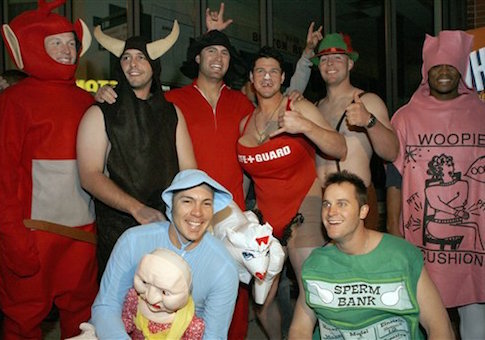Major League Baseball has banned what it once called a "life saving" tradition of veterans forcing rookie players to wear dresses.
MLB announced the creation of an "Anti-Hazing and Anti-Bullying" policy as part of its new labor agreement, which will prohibit hazing because rookies wearing women's clothing is "insensitive" and "potentially offensive."
The league once credited hazing, specifically the cheerleading boots Cleveland Indians rookie Kyle Denney was wearing in 2004, as being a life saving practice.
"Rookie hazing saves lives," wrote MLB.com reporter Zack Meisel in July 2012.
"Eight years ago, Kyle Denney was riding on the Indians' team bus in Kansas City when a bullet whizzed through the side of the vehicle and struck the pitcher in the leg," Meisel continued. "Fortunately, the white boots he was wearing as part of a cheerleading costume lessened the blow and kept Denney from significant harm."
Denney said he was "grateful" to be wearing the high white boots as part of his outfit as a University of Southern California cheerleader after the incident.
"I've never been so glad to have a USC thing on," Denney said. An Indians spokesman said a team trainer believed the " the boots may have saved Kyle from further injury."
MLB.com also argued hazing "provides entertainment," and "humbles youngsters."
But now MLB says, "times have changed."
The league's new anti-bullying policy, first obtained by the Associated Press, bans "requiring, coercing or encouraging" rookies from "dressing up as women or wearing costumes that may be offensive to individuals based on their race, sex, nationality, age, sexual orientation, gender identify or other characteristic."
The rule will be enforced regardless if teammates want to participate in the hazing tradition that goes back decades.
"[A] player's actual or perceived willingness to participate in prohibited conduct does not excuse the activity from being considered a violation of the policy," the league said using language reminiscent to the federal government's definition of gender identity.
MLB vice president Paul Mifsud said players could no longer dress up as women because the pictures were circulated on social media.
Mifsud said the MLB views baseball players—grown men who earn a minimum of $507,500 a year—dressing up as Disney princesses as "insensitive and potentially offensive to a number of groups."
"Times have changed. There is certain conduct that we have to be conscious of," said MLB Players Association general counsel Dave Prouty. "The important thing for us was to recognize there was a policy but to preserve the players' rights to challenge the level of discipline and the imposition of discipline."
MLB.com columnist Richard Justice praised the ban, saying it is "not OK" for players to wear "outfits that cross a line regarding sexual identity, sexual orientation, or race."
Justice said throwing out the entire ritual was justified even if just one player was offended.
"Here's guessing that most players were unbothered by the whole experience," he wrote. "If just one was, that's one too many. "
MLB did not always hold this view. Aside from arguing the practice saved Denney's life, the league used to remark that hazing rituals were "fun."
Just four years ago the league posted multiple videos on its website of Tampa Bay Rays rookies dressing up as ladies and performing a dance routine.
"The Tampa Bay Rays have some fun hazing their rookies by making them dress up as women and dance to the song 'Call Me, Maybe,'" the MLB said.
The public also used to be able to vote for their favorite hazing photos on MLB.com.
MLB said only dressing up as women is banned, and players can still dress up as a ketchup bottle, super heroes, or Gumby.
Players have expressed appreciation for hazing as a "rite of passage" in the past.
"When you're a young guy and you come up, that's just how it goes," Indians pitcher Joe Smith told MLB.com in 2012. "You take your licks and keep your mouth shut and do your job and before you know it, it's over."
Some examples of the ritual include Baltimore Orioles third baseman Manny Machado wearing a tutu during his rookie season in 2012, and this year the New York Mets forced their rookies wear outfits from the women's baseball team in the film A League of Their Own.
Angels' all-star and two-time MVP Mike Trout "wasn't the best-looking Hooters chick" when he was hazed. He also had to dress up as Lady Gaga.
Responding to the anti-hazing policy, Mets ace Noah Syndergaard said he did not understand why the MLB implemented the ban, adding hazing was fun when Curtis Granderson made him and his fellow rookies wear tighty whities.
"He's great, he keeps it fun," he said. "It's not really embarrassing to us, so we wear basically tighty whities and pajamas themed on super heroes and just walked the streets of Cincinnati. It was a fun time. It's part of it, you gotta embrace it."
Other players were angered by the ban, including former Red Sox player Kevin Youkilis.
"Seriously?! Had to wear a Hooters outfit going through customs in Toronto and wore it proudly [because] I was in the Show," he said in a tweet that he later deleted.
"I think we need to put into perspective the things we fight against in this country vs world problems. Aleppo vs MLB players dressing up," Youkilis added.
